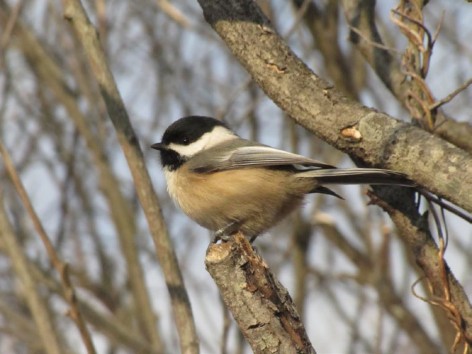David M. Larson

Black-capped Chickadee. Photograph by Peter Oehlkers.
For tasty morsels like songbirds, being aware of the surroundings and alert to the dangers of predators is a critical skill set. Membership in a mixed feeding flock can be advantageous, since different species with diverse viewpoints can help the group detect danger and sound the alarm. Behavioral, visual, and auditory clues all can help with predator avoidance. Many species respond stereotypically to visual cues of different predators; for instance, Red-winged Blackbirds mount a more vigorous response to a Red-tailed Hawk than to an American Kestrel.
But what about using auditory clues from the predator? Birders know well that vocalizations of potential predators can attract prey species. Presumably knowing the exact location of that screech owl—or the human mimic—provides a level of certainty and safety. The response of birds can often be scolding and mobbing, so keeping the predator in sight and alerting and attracting conspecifics and other species to the threat seems a good defense mechanism.
Do birds react differently to the vocalizations of potential predators and the specific threats they pose? Billings et al. (2015) conducted a series of audio playback and recording experiments in Montana and Washington in winter on mixed flocks containing three species of chickadees: Black-capped (Poecile atricapillus), Mountain (P. gambeli), and Chestnut-backed (P. rufescens). They played vocalizations of three predators: Northern Pygmy-Owl (Glaucidium gnoma), Sharp-shinned Hawk (Accipiter striatus), and Northern Goshawk (Accipiter gentilis) and one nonpredator control, Townsend’s Solitaire (Myadestes townsendi) and recorded the vocal responses from the chickadees.
The authors made audio recordings during and after playback of the calls of the predators and the solitaire. Analysis of these recordings indicated changes in multiple acoustic variables in response to the calls of predators and control, different responses to each of the predators, and different responses of the chickadee species.
The three species of chickadees all produce chick-a-dee calls, made up of chicka and dee elements in various proportions. They also produce independent chicka calls and dee calls as well as a variety of high-pitched calls. The variety in these calls suggests additional information content in the structure of the calls and combinations of calls. All three species were recognizable from full chick-a-dee calls. The shorter, independent chicka calls from Black-capped and Mountain chickadees were not separable but could be distinguished from Chestnut-backed. All three species also produce high-pitched seet and other calls that could not be assigned to species from the recordings.
The results of these field experiments indicated that Black-capped Chickadees increased the number of full chick-a-dee calls during and especially after playback of Northern Pygmy-Owl, in comparison to the control or the other two raptors. However, they showed only minor variation in the number of chicka and dee elements within the chick-a-dee call.
Similarly, Mountain Chickadees increased the number of chick-a-dee calls in playback and post-playback response to Pygmy-owl calls, and they also increased the number of dee elements in those calls during playback. Mountain Chickadees also increased the number of dee elements during playback—but not post-playback—of Northern Goshawk calls. Both Black-capped and Mountain chickadees increased the number of independent chicka calls in response to Pygmy-owl calls both during playback and post-playback.
In contrast to the response of the other two chickadees, Chestnut-backed Chickadees showed little significant change in chick-a-dee or chicka calls to raptor vocalizations.
All three species of chickadees significantly increased the number of high frequency calls in response to Sharp-shinned Hawk calls during the post-playback period, but not during playback.
These experiments demonstrate that chickadees can distinguish between the calls of different raptors. Black-capped and Mountain chickadees respond more vigorously to smaller—more dangerous—raptors, especially Northern Pygmy-Owl, than to the more remote threat of Northern Goshawk. In response to Pygmy-owl calls, both chickadees produce more complete chick-a-dee calls and more independent chicka calls during playback and post-playback. Since the Mountain Chickadees responded to Northern Goshawk calls with more dee elements, it is possible that their encoding for low- and high-threat species differs from that of Black-capped.
The high-frequency response of chickadees to Sharp-shinned Hawk calls, which was only apparent in the post-playback period, suggests encoding of more threat information based on the type of raptor. Northern Pygmy-Owls are slow fliers that rely on perch-and-pounce hunting tactics, and they can be mobbed and often driven away by a vigorous response. In contrast, Sharpshins are agile, fast fliers that can come out of nowhere to attack. A Sharpshin that just stopped vocalizing could be in flight, nearby, and an acute threat. The increased high-frequency calling from chickadees could signal the heightened risk of a raptor in flight and an imminent danger.
The lack of detected response in chick-a-dee and chicka calls of Chestnut- backed Chickadees to the auditory threats that triggered responses from the other two chickadees could be a reflection of evolutionary divergence between Chestnut-backed Chickadee and the more closely related sister species, Black-capped and Mountain chickadees.
Clearly, chickadees show graded vocal responses to detection of potential threats, based on a nuanced interpretation of the threat level. And, for birders, listening carefully to the mobbing calls might give a clue as to what raptor is around.
Reference
- Billings, A. C., E. Greene, and S. M. De La Lucia Jensen. 2015. Are chickadees good listeners? Antipredator responses to raptor vocalizations. Animal Behaviour 110: 1-8. Accessed 1/16/16.
David M. Larson, PhD, is the Science and Education Coordinator at Mass Audubon’s Joppa Flats Education Center in Newburyport, the Director of Mass Audubon’s Birder’s Certificate Program and the Certificate Program in Bird Ecology (a course for naturalist guides in Belize), a domestic and international tour leader, Vice President of the Nuttall Ornithological Club, and a member of the editorial staff of Bird Observer.